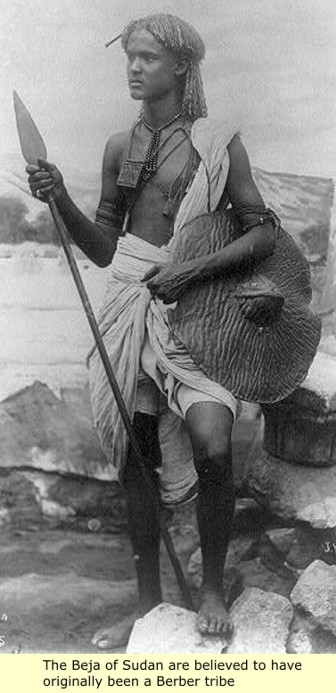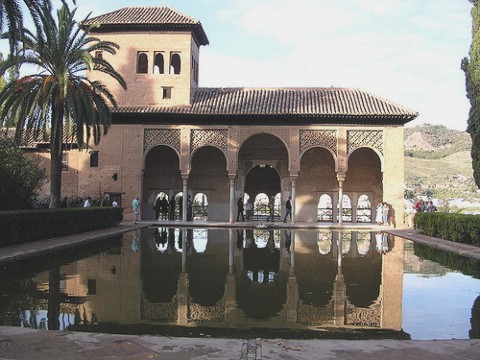Ancient Man and His First Civilizations
The True Negro (2a)
The Berbers-Tuareg-Moors of North Africa
(All of these terms are actually foreign designations, and offensive to the people)
Iberia
(Spain and Portugal)
 The Iberian Peninsula because of its close proximity to Africa, has been inhabited for at least 1,000,000 years. At about 45,000 B.C. the Khoisan type African “Grimaldi,” became the first “Modern Man” to enter Europe; as he crossed the Gibraltar straits and started his journey across Europe. (Europe and Africa are NOW separated by 7.7 nautical miles - during glacial periods it was much less). The Iberian Peninsula because of its close proximity to Africa, has been inhabited for at least 1,000,000 years. At about 45,000 B.C. the Khoisan type African “Grimaldi,” became the first “Modern Man” to enter Europe; as he crossed the Gibraltar straits and started his journey across Europe. (Europe and Africa are NOW separated by 7.7 nautical miles - during glacial periods it was much less).
During the Neolithic expansion, various megalithic cultures developed in Iberia. An open seas navigation culture from the east Mediterranean, probably from Crete, called the Cardium culture, also extended its influence to the eastern coasts of Iberia, possibly as early as the 5th millennium B.C.
In the Chalcolithic or Copper Age (c. 3000 B.C. in Iberia) a series of complex cultures developed, which would give rise to the first civilizations in Iberia and to extensive exchange networks reaching to the Baltic, the Middle East and North Africa. At about 2150 B.C. the Bell Beaker culture intruded into Chalcolithic Iberia, being of Celtic origin.
Around 1100 B.C. Phoenician merchants founded the trading colony of Gadir or Gades (modern day Cádiz) near Tartessos. In the 8th century B.C. the first Whites arrived, the Greeks established colonies such as Emporion (modern Empúries), these were founded along the Mediterranean coast on the East, leaving the south coast to the Phoenicians. The Greeks are responsible for the name Iberia, after the river Iber (Ebro). In the 6th century B.C. the Phoenician Carthaginians arrived in Iberia while struggling with the Greeks for control of the Western Mediterranean. Their most important colony was Carthago Nova (Latin name of modern day Cartagena).

In 219 B.C. the first Roman troops invaded the Iberian Peninsula, this during the Second Punic war against the Carthaginians. After two centuries of war with the Celtic and Iberian tribes, and also the Phoenician, Greek and Carthaginian colonies, Rome annexed it under Augustus, resulting in the creation of the province of Hispania. It was divided into Hispania Ulterior and Hispania Citerior during the late Roman Republic, and during the Roman Empire, it was divided into Hispania Taraconensis in the northeast, Hispania Baetica in the south and Lusitania in the southwest.
In the early 5th century A.D. new Whites invaded, these were Germanic tribes from Eastern Europe, namely the Suevi, the Vandals (Silingi and Hasdingi) and their allies, the Sarmatian Alans. Only the kingdom of the Suevi (Quadi and Marcomanni) would endure after the arrival of another wave of Germanic invaders - The Visigoths; who had earlier established their own kingdom with its capital at Toulouse France. They slowly extended their authority into Hispania, displacing the Vandals and Alans. The Visigoths, subsequently conquered all of the Iberian peninsula and expelled or partially integrated the Vandals and the Alans. The Visigoths eventually conquered the Suevi kingdom and its capital city Bracara (modern day Braga) in 584-585 A.D. They would also conquer the province of the Byzantine Empire Spania, in the south of the peninsula and the Balearic Islands.
The Moors
White historians, in their bid to make ancient Europeans seem White, have chosen to ignore the "obvious" relationships that must have existed between Berbers and the people of iberia. When Grimaldi crossed the Gibraltar straits to enter Europe, all of his kind did not follow. When Humans move to new territories "Most" stay behind in the old territory, and they "maintain" their relationships; there is always back and forth travel for trade and communication. It is against this backdrop that the Berber invasion of Iberia must be viewed. The Berbers did not enter Iberia as destroyers, they entered as builders!
Thus, after Muhammad's Islamic army took Egypt in 640 A.D. and then went on to conquer all of North Africa. The Berbers no-doubt saw this new Black army as an opportunity; so rather than fight, the Berbers joined forces with the Islamic army. In 711 A.D. A Berber army led by general Tariq ibn Ziyad, invaded Iberia (Spain) and overthrew the White Visigoths (Western Goths): Who were one of two main branches of the Goths, an east Germanic tribe, who over the period of only one hundred years, had migrated from eastern Europe, thru Greece, thru Italy, and finally down into the Iberian peninsula.
In Iberia (Spain and Portugal), the Berbers, now known as Moors, created a highly advanced civilization and culture, famous for it’s art, architecture, and centers of learning. While having rule over Spain: The Berbers, who themselves fifty years earlier had been forced to accept Islam, now sometimes forced the inhabitants of Iberia to do the same. Though the number of original "Moors" remained small, many native Iberian inhabitants converted to Islam. According to Ronald Segal, some 5.6 million of Iberia's 7 million inhabitants were Muslim by 1200 A.D, virtually all of them native inhabitants. According to historian Richard A. Fletcher, the number of Arabs who settled in Iberia was very small. There were about 900,000 Berbers and about 90,000 Arabs in Iberia. (More history below).
 
Muslim Spain and European Culture
Dean Derhak
When you think of European culture, one of the first things that may come to your mind is the renaissance. Many of the roots of European culture can be traced back to that glorious time of art, science, commerce and architecture. But did you know that long before the renaissance there was a place of humanistic beauty in Muslim Spain? Not only was it artistic, scientific and commercial, but it also exhibited incredible tolerance, imagination and poetry. Moors, as the Spaniards call the Muslims, populated Spain for nearly 700 years. As you'll see, it was their civilization that enlightened Europe and brought it out of the dark ages to usher in the renaissance. Many of their cultural and intellectual influences still live with us today.
Way back during the eighth century, Europe was still knee-deep in the Medieval period. That's not the only thing they were knee-deep in. In his book, "The Day The Universe Changed," the historian James Burke describes how the typical European townspeople lived:
"The inhabitants threw all their refuse into the drains in the center of the narrow streets. The stench must have been overwhelming, though it appears to have gone virtually unnoticed. Mixed with excrement and urine would be the soiled reeds and straw used to cover the dirt floors.
This squalid society was organized under a feudal system and had little that would resemble a commercial economy. Along with other restrictions, the Catholic Church forbade the lending of money - which didn't help get things booming much. "Anti-Semitism, previously rare, began to increase. Money lending, which was forbidden by the Church, was permitted under Jewish law." (Burke, 1985, p. 32) Jews worked to develop a currency although they were heavily persecuted for it. Medieval Europe was a miserable lot, which ran high in illiteracy, superstition, barbarism and filth.
During this same time, Arabs entered Europe from the South. ABD AL-RAHMAN I, a survivor of a family of caliphs of the Arab empire, reached Spain in the mid-700's. He became the first Caliph of Al-Andalus, the Moorish part of Spain, which occupied most of the Iberian Peninsula. He also set up the UMAYYAD Dynasty that ruled Al-Andalus for over three-hundred years. (Grolier, History of Spain). Al Andalus means, "the land of the Vandals," from which comes the modern name Andalusia.
 |
At first, the land resembled the rest of Europe in all its squalor. But within two-hundred years the Moors had turned Al-Andalus into a bastion of culture, commerce and beauty. "Irrigation systems imported from Syria and Arabia turned the dry plains... into an agricultural cornucopia. Olives and wheat had always grown there. The Arabs added pomegranates, oranges, lemons, aubergines, artichokes, cumin, coriander, bananas, almonds, pams, henna, woad, madder, saffron, sugar-cane, cotton, rice, figs, grapes, peaches, apricots and rice." (Burke, 1985, p. 37)
By the beginning of the ninth century, Moorish Spain was the gem of Europe with its capital city, Cordova. With the establishment of Abdurrahman III - "the great caliphate of Cordova" - came the golden age of Al-Andalus. Cordova, in southern Spain, was the intellectual center of Europe.
At a time when London was a tiny mud-hut village that "could not boast of a single streetlamp" (Digest, 1973, p. 622), in Cordova "there were half a million inhabitants, living in 113,000 houses. There were 700 mosques and 300 public baths spread throughout the city and its twenty-one suburbs. The streets were paved and lit." (Burke, 1985, p. 38) The houses had marble balconies for summer and hot-air ducts under the mosaic floors for the winter. They were adorned with gardens with artificial fountains and orchards". (Digest, 1973, p. 622) "Paper, a material still unknown to the west, was everywhere. There were bookshops and more than seventy libraries." (Burke, 1985, p. 38).
This rich and sophisticated society took a tolerant view towards other faiths. Tolerance was unheard of in the rest of Europe. But in Moorish Spain, "thousands of Jews and Christians lived in peace and harmony with their Muslim overlords." (Burke, 1985, p. 38) The society had a literary rather than religious base. Economically their prosperity was unparalleled for centuries. The aristocracy promoted private land ownership and encouraged Jews in banking. There was little or no Muslim prostelyting. Instead, non-believers simply paid an extra tax!
In another of James Burke's works titled "Connections," he describes how the Moors thawed out Europe from the Dark Ages. "But the event that must have done more for the intellectual and scientific revival of Europe was the fall of Toledo in Spain to the Christians, in 1105." In Toledo the Arabs had huge libraries containing the lost (to Christian Europe) works of the Greeks and Romans along with Arab philosophy and mathematics. "The Spanish libraries were opened, revealing a store of classics and Arab works that staggered Christian Europeans." (Burke, 1978, p. 123)
 
The intellectual plunder of Toledo brought the scholars of northern Europe like moths to a candle. The Christians set up a giant translating program in Toledo. Using the Jews as interpreters, they translated the Arabic books into Latin. These books included "most of the major works of Greek science and philosophy... along with many original Arab works of scholarship." (Digest, p. 622) "The intellectual community which the northern scholars found in Spain was so far superior to what they had at home that it left a lasting jealousy of Arab culture, which was to color Western opinions for centuries" (Burke, 1985, p. 41)
 |
"The subjects covered by the texts included medicine, astrology, astronomy pharmacology, psychology, physiology, zoology, biology, botany, mineralogy, optics, chemistry, physics, mathematics, algebra, geometry, trigonometry, music, meteorology, geography, mechanics, hydrostatics, navigation and history." (Burke, 1985, p. 42) These works alone however, didn't kindle the fire that would lead to the renaissance. They added to Europe's knowledge, but much of it was unappreciated without a change in the way Europeans viewed the world.
| The Alhambra (Calat Alhambra, "the red fortress"), is a palace and fortress complex constructed during the mid 14th century by the Moorish rulers of Al-Andalus, occupying a hilly terrace on the southeastern border of the city of Granada.
|
The Berbers (Moors), like the Arabs, were very fond of Turkish women, they kept their Harems well stocked with them.
|
 
 
|










